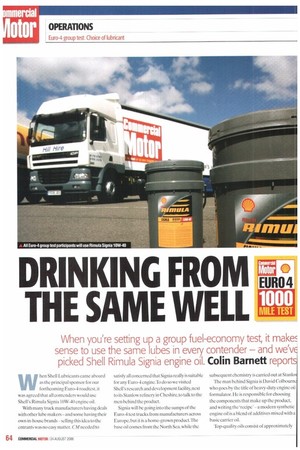DRINKING FROM THE SAME WELL
Page 64

Page 65

If you've noticed an error in this article please click here to report it so we can fix it.
When you're setting up a group fuel-economy test, it makes sense to use the same tubes in every contender — and we'v picked Shell Rim ula Signia engine oil. Colin Barnett reports
When Shell Lubricants came aboard as the principal sponsor for our forthcoming Euro-4 roadtest, it was agreed that all contenders would use Shell's Rimula Signia IOW-40 engine oil.
With many truck manufacturers having deals with other lube makers—and some having their own in-house brands —selling this idea to the entrants was no easy matter. CM needed to satisfy all concerned that Signia really is suitable for any Euro-4 engine:lb do so we visited Shell's research and development facility,next to its Stanlow refinery in Cheshire, to talk to the men behind the product.
Signia will be going into the sumps of the Euro-4 test trucks from manufacturers across Europe, but it is a home-grown product:The base oil comes from the North Sea. whi le the subsequent chemistry is carried out at Stanlo‘ The man behind Signia is David Colbourn who goes by the title of heavy-duty engine oil formulator. He is responsible for choosing the components that make up the product, and writing the 'recipe' — a modern synthetic engine oil is a blend of additives mixed with a basic carrier oil.
Top-quality oils consist of approximately 80% carrier oil and 20% additive. Despite the name, synthetic oil comes from the same place as conventional oih'svnthetic" refers to a manufacturing process that modifies the molecular structure to improve its performance.
With only four major additive manufacturers in the world market, Colbourne needs to ensure not only that the recipe works, but that the chosen additives can be supplied at the right price — and that supplies will not be cut off.
Exhaust after-treatment Development ot Signia began in 2001 when engine manufacturers realised that the Euro-4 emissions standard would require some form of exhaust after-treatment, whether by the use of diesel particulate filters (DPFs) or by a chemical injection process, which we now know as the SCR or AdBlue approach.
Euro-4 EGR and SCR engines have different lubrication demands, but both require lows-SAPS oils—SAPS being the iulphated ash, phosphorous and sulphur residues produced by the combustion of the :iny quantities of lubricant inevitable in even he most oil-tight engine.
In EGR engines, sulphated ash (a light grey Just composed of tiny particles of calcium and tine) eventually chokes the passage of exhaust ps through the DPF. gradually increasing :xhaust back pressure to the point that engine :fficiency suffers.
While much of the sulphated ash can be .emoved mechanically, it will eventually ;horten the life of the DPF— so it is better to nevent ash formation at source.
With SCR truck engines, the issues are ;lightly less clear-cut, and centre around the oxidising catalytic converter used in conjunction with the AdBlue process.
With the arrival of three-way catalysts for cars some years ago, there were real fears that phosphorous and, more probably, sulphur in the fuel could pollute the catalyst. The chemistry could be likened to carbon monoxide poisoning in the human body, where carbon monoxide occupies space in the blood that should be carrying oxygen. In a catalytic converter, phosphorous and sulphur would occupy space on the metallic coatings that should be used to capture pollutants.
In reality, there is little evidence of sulphur affecting truck engine catalysts.This is largely due to the success of low-sulphur diesel, IC) the point that engine lubricant could be responsible for as much sulphur emission as the fuel.
The requirements for Euro-6 have not yet been finalised, but they are likely to result in N Ox-absorbing technology which will be particularly sensitive to sulphur emission—so it makes sense to incorporate the low-SAPS package now. •
























































































































































































